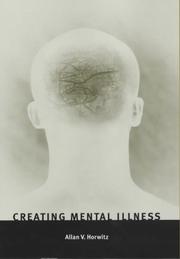| Listing 1 - 10 of 22 | << page >> |
Sort by
|

ISBN: 0226353818 9780226353821 0226353826 9780226353814 Year: 2002 Publisher: Chicago ; London : University of Chicago Press,
Abstract | Keywords | Export | Availability | Bookmark
 Loading...
Loading...Choose an application
- Reference Manager
- EndNote
- RefWorks (Direct export to RefWorks)
Deviant behavior --- Psychiatry --- Labeling theory. --- History --- Philosophy. --- Labeling theory --- Théorie de l'étiquetage --- Afwijkend gedrag. --- Stigmatisering (sociale wetenschappen) --- Psychische Störung. --- Wissenschaftstheorie. --- Konstrukt. --- Étiquetage, Théorie de l' --- 1900-1999 --- Stigmatisering (sociale wetenschappen). --- Étiquetage, Théorie de l'. --- Théorie de l'étiquetage --- Aufsatzsammlung. --- Déviance --- Philosophy, Medical. --- Psychiatrie --- Psychiatrie. --- Psychiatry. --- Social Medicine. --- Histoire --- Philosophie. --- history. --- 1900-1999. --- Déviance --- Philosophie
Book
ISBN: 0190603283 0190603240 9780190603267 0190603267 9780190603281 9780190603274 0190603275 9780190603250 9780190603243 0190603259 Year: 2016 Publisher: New York, NY : Oxford University Press,
Abstract | Keywords | Export | Availability | Bookmark
 Loading...
Loading...Choose an application
- Reference Manager
- EndNote
- RefWorks (Direct export to RefWorks)
In 'What's Normal?', Allan Horwitz examines the roles that biological and social forces play in determining human behaviour. Rather than attempting to solve these issues universally, Horwitz demonstrates that both social and biological mechanisms have varying degrees of influence in different situations.
Human behavior. --- Human biology --- Cognitive psychology. --- Social aspects. --- Psychology, Cognitive --- Cognitive science --- Psychology --- Action, Human --- Behavior, Human --- Ethology --- Human action --- Human beings --- Physical anthropology --- Social sciences --- Psychology, Comparative --- Behavior
Book
ISBN: 1421410818 9781421410814 9781421410807 142141080X Year: 2013 Publisher: Baltimore : Johns Hopkins University Press,
Abstract | Keywords | Export | Availability | Bookmark
 Loading...
Loading...Choose an application
- Reference Manager
- EndNote
- RefWorks (Direct export to RefWorks)
As Horwitz explores the history and multiple identities of anxiety--melancholia, nerves, neuroses, phobias, and so on--it becomes clear that every age has had its own anxieties and that culture plays a role in shaping how anxiety is expressed.
Anxiety --- Anxiety Disorders --- Anxiety neuroses --- Anxiety states, Neurotic --- Neurotic anxiety states --- Neuroses --- Angst --- Anxieties --- Anxiousness --- Emotions --- Stress (Psychology) --- Agitation (Psychology) --- Fear --- Worry --- history. --- Anxiety disorders --- History.
Book
ISBN: 1421426404 9781421426402 9781421426396 1421426390 Year: 2018 Publisher: Baltimore : Baltimore, Md. : Johns Hopkins University Press, Project MUSE,
Abstract | Keywords | Export | Availability | Bookmark
 Loading...
Loading...Choose an application
- Reference Manager
- EndNote
- RefWorks (Direct export to RefWorks)
Post-traumatic stress disorder - and its predecessor diagnoses, including soldier’s heart, railroad spine, and shell shock - was recognized as a psychiatric disorder in the latter part of the nineteenth century. The psychic impacts of train crashes, wars, and sexual shocks among children first drew psychiatric attention. Later, enormous numbers of soldiers suffering from battlefield traumas returned from the world wars. It was not until the 1980s that PTSD became a formal diagnosis, in part to recognize the intense psychic suffering of Vietnam War veterans and women with trauma-related personality disorders. PTSD now occupies a dominant place in not only the mental health professions but also major social institutions and mainstream culture, making it the signature mental disorder of the early twenty-first century.In PTSD, Allan V. Horwitz traces the fluctuations in definitions of and responses to traumatic psychic conditions. Arguing that PTSD, perhaps more than any other diagnostic category, is a lens for showing major historical changes in conceptions of mental illness, he surveys the conditions most likely to produce traumas, the results of those traumas, and how to evaluate the claims of trauma victims.Illuminating a number of central issues about psychic disturbances more generally—including the relative importance of external stressors and internal vulnerabilities in causing mental illness, the benefits and costs of mental illness labels, and the influence of gender on expressions of mental disturbance - PTSD is a compact yet comprehensive survey. The book will appeal to diverse audiences, including the educated public, students across the psychological and social sciences, and trauma victims who are interested in socio-historical approaches to their condition.
Book
ISBN: 9781421440699 9781421440705 1421440709 1421440709 1421440695 Year: 2021 Publisher: Baltimore, Maryland : Johns Hopkins University Press,
Abstract | Keywords | Export | Availability | Bookmark
 Loading...
Loading...Choose an application
- Reference Manager
- EndNote
- RefWorks (Direct export to RefWorks)
This comprehensive treatment should appeal to not only specialists but anyone who is interested in how diagnoses of mental illness have evolved over the past seven decades--from unwanted and often imposed labels to resources that lead to valued mental health treatments and social services.
Mental illness --- Psychiatry --- Classification --- History. --- Diagnosis --- Diagnostic and statistical manual of mental disorders. --- Mental Disorders --- Madness --- Mental diseases --- Mental disorders --- Disabilities --- Psychology, Pathological --- Mental health --- History --- classification --- history --- History, 20th Century --- History, 21st Century --- diagnosis --- United States
Book
ISBN: 9781421446103 Year: 2023 Publisher: Baltimore (Md) Johns Hopkins University Press
Abstract | Keywords | Export | Availability | Bookmark
 Loading...
Loading...Choose an application
- Reference Manager
- EndNote
- RefWorks (Direct export to RefWorks)
Book
ISBN: 0123561809 Year: 1982 Publisher: Orlando, Fla
Abstract | Keywords | Export | Availability | Bookmark
 Loading...
Loading...Choose an application
- Reference Manager
- EndNote
- RefWorks (Direct export to RefWorks)
Book
ISBN: 9781421446110 Year: 2023 Publisher: Baltimore, Maryland : Johns Hopkins University Press,
Abstract | Keywords | Export | Availability | Bookmark
 Loading...
Loading...Choose an application
- Reference Manager
- EndNote
- RefWorks (Direct export to RefWorks)
"In this book, the author explores how personality disorders rose to prominence in a variety of disciplines and the controversies they have generated. It will consider the variety of ways that personalities have been seen as "disorders" and tied to or separated from other kinds of mental disorders. Relatedly, it will examine how the notion of the "personality disorder" has involved negative moral and cultural evaluations that are more related to social deviance than to medical conditions"
Personality disorders --- History. --- Treatment --- Social aspects.

ISBN: 0521567637 Year: 1999 Publisher: Cambridge Cambridge University Press
Abstract | Keywords | Export | Availability | Bookmark
 Loading...
Loading...Choose an application
- Reference Manager
- EndNote
- RefWorks (Direct export to RefWorks)

ISBN: 030643475X 1489922326 148992230X 9780306434754 Year: 1990 Publisher: New York (N.Y.): Plenum,
Abstract | Keywords | Export | Availability | Bookmark
 Loading...
Loading...Choose an application
- Reference Manager
- EndNote
- RefWorks (Direct export to RefWorks)
| Listing 1 - 10 of 22 | << page >> |
Sort by
|

 Search
Search Feedback
Feedback About UniCat
About UniCat  Help
Help News
News